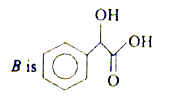Treatment of propionaldehyde with dil. NaOH solution gives
CH3CH2COOCH2CH2CH3
CH3CH2CHOHCH(CH3)CHO
CH3CH2CHOHCH2CH2CHO
CH3CH2COCH2CH2CHO
The correct Answer is:B
To solve the question regarding the treatment of propionaldehyde with dilute NaOH solution, we can follow these steps:
1. Identify the Structure of Propionaldehyde:
- Propionaldehyde, also known as propanal, has the chemical formula CH3CH2CHO. It consists of a three-carbon chain with an aldehyde functional group at one end.
2. Understand the Reaction Conditions:
- The reaction involves treating propionaldehyde with dilute sodium hydroxide (NaOH). This is a basic condition that can lead to an aldol condensation reaction.
3. Formation of Enolate Ion:
- In the presence of a base like NaOH, the alpha hydrogen (the hydrogen attached to the carbon adjacent to the carbonyl group) of propionaldehyde can be removed. This results in the formation of an enolate ion:
CH3CH2C(=O)H→CH3CH2C−+H2O
4. Nucleophilic Attack:
- The enolate ion acts as a nucleophile and attacks the carbonyl carbon of another molecule of propionaldehyde. This forms a β-hydroxy aldehyde (an aldol):
CH3CH2C−+CH3CH2CHO→CH3CH2C(OH)(CH2CH3)CHO
5. Formation of Aldol Product:
- The product formed from the above reaction is 3-hydroxybutanal (an aldol). The structure can be represented as:
CH3CH2C(OH)(CH2CHO) or CH3CH(OH)CH2CHO
6. Dehydration (if applicable):
- Under certain conditions (e.g., heating), the aldol product can undergo dehydration to form an α,β-unsaturated aldehyde. However, if we are only considering the immediate product of the reaction with dilute NaOH, we will focus on the aldol product.
7. Final Product:
- The final product of the reaction between propionaldehyde and dilute NaOH is 3-hydroxybutanal.
Summary:
The treatment of propionaldehyde with dilute NaOH results in the formation of 3-hydroxybutanal (an aldol product).
---
- Propionaldehyde, also known as propanal, has the chemical formula CH3CH2CHO. It consists of a three-carbon chain with an aldehyde functional group at one end.
- The reaction involves treating propionaldehyde with dilute sodium hydroxide (NaOH). This is a basic condition that can lead to an aldol condensation reaction.
- In the presence of a base like NaOH, the alpha hydrogen (the hydrogen attached to the carbon adjacent to the carbonyl group) of propionaldehyde can be removed. This results in the formation of an enolate ion:
CH3CH2C(=O)H→CH3CH2C−+H2O
- The enolate ion acts as a nucleophile and attacks the carbonyl carbon of another molecule of propionaldehyde. This forms a β-hydroxy aldehyde (an aldol):
CH3CH2C−+CH3CH2CHO→CH3CH2C(OH)(CH2CH3)CHO
- The product formed from the above reaction is 3-hydroxybutanal (an aldol). The structure can be represented as:
CH3CH2C(OH)(CH2CHO) or CH3CH(OH)CH2CHO
- Under certain conditions (e.g., heating), the aldol product can undergo dehydration to form an α,β-unsaturated aldehyde. However, if we are only considering the immediate product of the reaction with dilute NaOH, we will focus on the aldol product.
- The final product of the reaction between propionaldehyde and dilute NaOH is 3-hydroxybutanal.
The treatment of propionaldehyde with dilute NaOH results in the formation of 3-hydroxybutanal (an aldol product).
Topper's Solved these Questions
- ALDEHYDES, KETONES AND CARBOXYLIC ACIDSBOOK - ICSECHAPTER - ALDEHYDES, KETONES AND CARBOXYLIC ACIDSEXERCISE - EXERCISE (PART-II DESCRIPTIVE QUESTIONS) (VERY SHORT QUESTIONS)
282 Videos
- ALDEHYDES, KETONES AND CARBOXYLIC ACIDSBOOK - ICSECHAPTER - ALDEHYDES, KETONES AND CARBOXYLIC ACIDSEXERCISE - EXERCISE (PART-II DESCRIPTIVE QUESTIONS) ( SHORT QUESTIONS)
581 Videos
- ALDEHYDES, KETONES AND CARBOXYLIC ACIDSBOOK - ICSECHAPTER - ALDEHYDES, KETONES AND CARBOXYLIC ACIDSEXERCISE - EXERCISE (PART-II DESCRIPTIVE QUESTIONS) ( LONG ANSWER QUESTIONS)
478 Videos
- ALCOHOLS, PHENOLS AND ETHERS BOOK - ICSECHAPTER - ALCOHOLS, PHENOLS AND ETHERS EXERCISE - ISC EXAMINATION QUESTIONS
25 Videos
- APPENDIX II ( TYPICAL CONVERSIONS)BOOK - ICSECHAPTER - APPENDIX II ( TYPICAL CONVERSIONS)EXERCISE - AROMATIC CONVERSIONS
98 Videos
Similar Questions
Knowledge Check
Chlorination of toluene in the presence of light and heat followed by treatment with aq. KOH and subsequently with dil. HCl gives :
A B
B C
C D
D
Compound (A) C8H6O2 on treatment with aq. NaOH followed by acidification gives (B) C3H2O3 which on oxidation gives benzoic acid only:
A B
B C
C D
D
Which of the following compounds will be obtained on treatment of propanal with dilute NaOH solution and why ?
View SolutionSulphur on boiling with NaOH solution gives
View SolutionA mixture of benzaldehyde and formaldehyde on heating with aqueous NaOH solution gives
View SolutionA mixture of formaldehyde and benzaldehyde on heating with aqueous NaOH solution gives :
View SolutionAssertion : Treatment of chloroethane with a saturated solution of AgCN gives ethyl isocyanide as the major product.
Reason : Cyanide(CN−) is an ambident nucelophile
View SolutionThe treatment of
 with concentrated NaOH gives
with concentrated NaOH gives
View Solution
